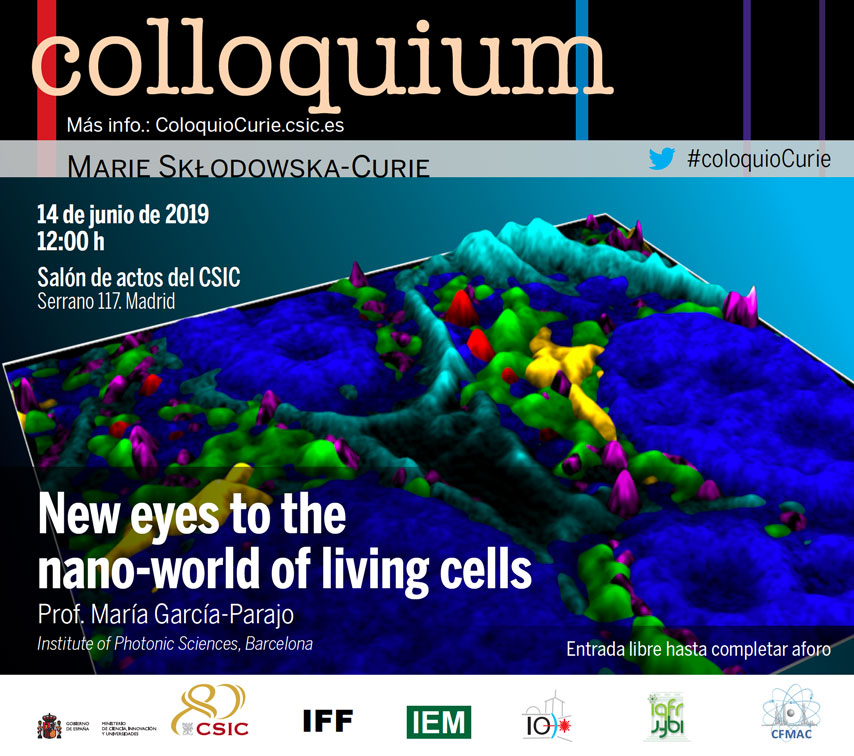
Desde la organización del Colloquium Marie Sklodowska Curie, iniciativa conjunta a cargo los institutos IO (Óptica), IEM (Estructura de la Materia), IFF (Física Fundamental) e IQFR (Química Física Rocasolano) del CSIC, tenemos el placer de anunciaros la novena conferencia del ciclo del mismo nombre, cuarta de la temporada 2018-2019, que se celebrará el viernes 14 de junio de 2019 a las 12:00 en el Salón de Actos Central del CSIC (Serrano 117, Madrid).
En esta ocasión la Prof. María García-Parajo, del Instituto de Ciencias Fotónicas (Barcelona), presentará la charla transdisciplinar “New eyes to the nano-world of living cells” sobre las nuevas técnicas de microscopía más allá del límite de difracción y su impacto en la investigación biomédica (ver abstract abajo).
Os recordamos que este ciclo de conferencias están protagonizadas por científicos de muy alto nivel internacional, y están destinadas a difundir el conocimiento científico y sus implicaciones/aplicaciones, haciéndolo accesible a público no especializado, en general, y en particular, a científicos, técnicos, profesionales y estudiantes universitarios de todas las disciplinas, no necesariamente coincidentes con la especialidad del orador.
ABSTRACT:
One general property and strategy of natural systems, including humans, is to organize different components by means of compartmentalization. This compartmentalization efficiently facilitates and orchestrates biological events in space and time. Cells are primary examples of well-defined biological compartments within tissues. However, cells also exhibit a number of compartmentalization strategies, including membrane-delimited intracellular organelles and multi-enzyme complexes. The compartmentalization of specific cellular functions, through spatial localization, increases regulation efficiency. At the nanometre scale, cells also organize their molecular components in a highly regulated way. Yet, visualization of these processes have been hidden until recently, due to the lack of non-invasive techniques that provide sufficient spatiotemporal resolution. A major breakthrough in optical microscopy occurred about 10 years ago when researchers invented different ways to overcome the barrier of diffraction of the light. The advent of these so-called super-resolution techniques and single molecule dynamic approaches are indeed providing new eyes to visualize the nano-world of living cells. From these studies, it is becoming clear that compartmentalization in space and time is a general feature of living cells and it operates from the cell membrane down to chromatin in the nucleus. In this talk, I will first describe the working principles of these advanced optical techniques and will then focus on recent studies in my group linking spatial and temporal organization at the nano- and meso-scales to different biological functions.









 Desde la organización del Colloquium Marie Sklodowska Curie, iniciativa conjunta a cargo los institutos IO (Óptica), IEM (Estructura de la Materia), IFF (Física Fundamental) e IQFR (Química Física Rocasolano) del CSIC, tenemos el placer de anunciaros la novena conferencia del ciclo del mismo nombre, cuarta de la temporada 2018-2019, que se celebrará el viernes 14 de junio de 2019 a las 12:00 en el Salón de Actos Central del CSIC (Serrano 117, Madrid).
Desde la organización del Colloquium Marie Sklodowska Curie, iniciativa conjunta a cargo los institutos IO (Óptica), IEM (Estructura de la Materia), IFF (Física Fundamental) e IQFR (Química Física Rocasolano) del CSIC, tenemos el placer de anunciaros la novena conferencia del ciclo del mismo nombre, cuarta de la temporada 2018-2019, que se celebrará el viernes 14 de junio de 2019 a las 12:00 en el Salón de Actos Central del CSIC (Serrano 117, Madrid).